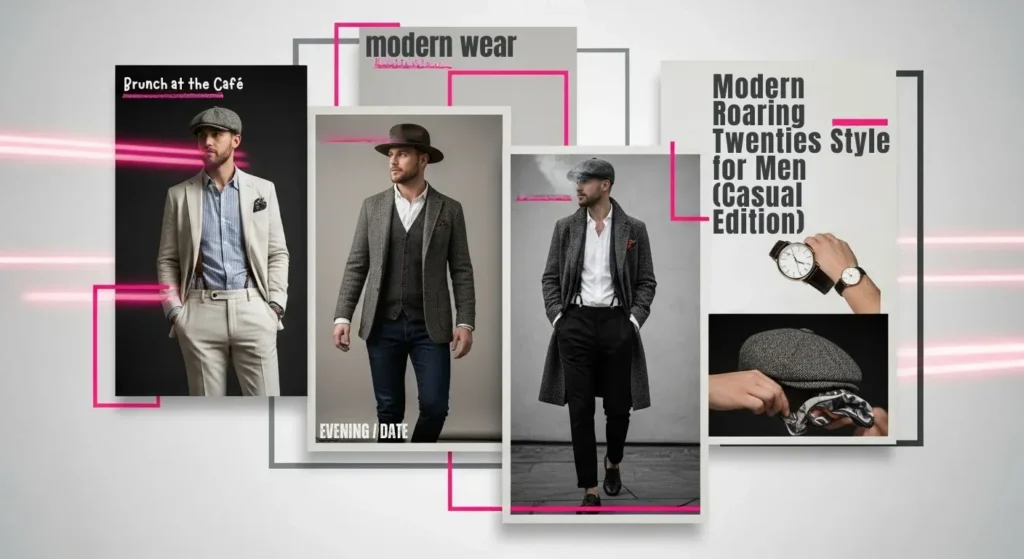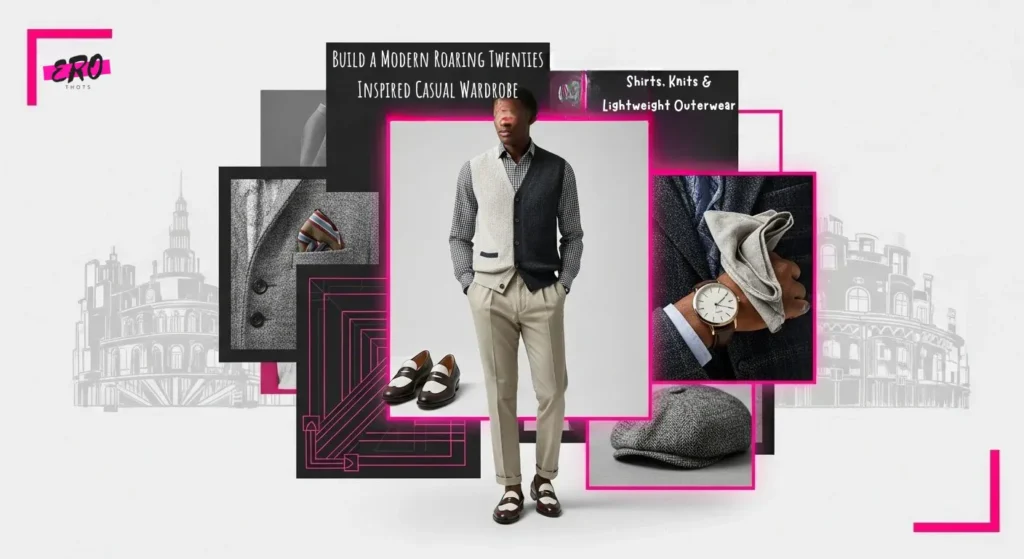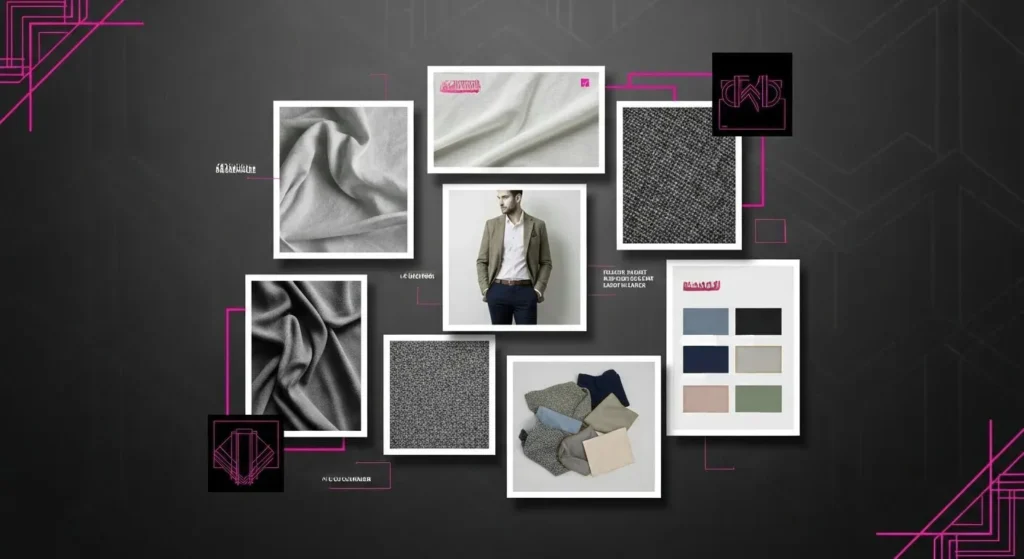
Imagine slipping into a quiet speakeasy in 1925 smoke swirling, jazz playing softly in the background, the floorboards creaking as dancers glide across. The men are sharp, elegant, and effortlessly cool. Now, imagine bringing a little of that energy into your everyday life, without looking like you just walked off a movie set.
That’s the idea behind modern roaring twenties style men casually taking the essence of the Jazz Age, its clean lines, refined details, and playful spirit and adapting them for today’s more relaxed settings. In this post, I’ll walk you through how to pull off casual Roaring Twenties inspired looks that feel fresh, wearable, and distinctive. You’ll discover style principles, outfit recipes, modern tweaks, and real world examples. By the end, you’ll know how to “dress like Gatsby but for brunch, not a ball.”
Style Principles of the Jazz Age
To adapt 1920s flair for casual modern wear, first you need to understand what made that era’s menswear special. These are the core principles that endure:
Structural Elegance
In the 1920s, suits and jackets had clean lines, slightly structured shoulders, and a defined waist but weren’t as stiff as the preceding Edwardian styles. The goal was refinement, not rigidity.
Use lightweight fabrics (mid weight cotton, linen blends) with soft shoulder construction. You get in shape without weight or bulk.
Elevated Detail, Subtle Flourishes
Men of the Jazz Age weren’t minimalist; they loved contrast piping, subtle stripes, decorative stitching, emblems, and piping. These details were never brash; they were just enough to show craftsmanship.
Choose garments with piped seams, subtle brocade textures, or contrast lapel stitching but use just one statement piece per outfit.
High Waist and Long Leg Line
Trousers in the 1920s sat higher, giving the illusion of longer legs. Paired with a slightly cropped jacket, it created a refined proportion.
You don’t need paper-bag waists but mid-rise chinos or trousers with a tailored cut can evoke that same vertical balance when paired with a shorter top layer.
Accessories as Identity Signals
Hats (fedoras, newsboy caps), suspenders, pocket squares, tie bars, and even slender wristwatches were not afterthoughts they were part of the narrative.
Modern tip: Use one or two signature accessories, say, a wool newsboy cap or a silk pocket square rather than going all-in with a full “costume” set.
Build a Modern Roaring Twenties Inspired Casual Wardrobe

Let’s get into the “meat” of the issue: putting together outfits that say “Jazz Age casual” without shouting “theme party.”
Tops: Shirts, Knits & Lightweight Outerwear
- Button-down shirts with subtle patterns: Think micro-checks, fine herringbone, or pinpoint Oxford more texture than pop. Leave collars open (no tie) for casual ease.
- Knit vests or sweater vests: A classic Jazz Age layer, but wear it over your shirt and under a blazer (or just solo) for a relaxed refinement.
- Cardigans or cropped pullovers: Use lighter knits (merino or cotton blends) in muted tones like charcoal, olive, or cream.
- Soft blazers / sport coats: Choose unstructured or half-lined designs in breathable fabrics like linen-wool or cotton twill. Keep lapels narrow to medium, reminiscent of the era, but in modern proportions.
Bottoms: Trousers, Chinos & Elevated Jeans
You want a nod to the 1920s leg line without overdoing it.
- Mid-rise chinos or dress trousers: Choose a tailored cut, a slight taper toward the ankle, and a clean front (no cargo pockets).
- Dark, slim-to-straight denim: A raw or selvedge jean (in dark indigo) can stand in for 1920s trousers when paired with a blazer and accessories.
- Pleated trousers (soft pleats): One soft pleat is fine; avoid the deep, dramatic ones. It gives a little vintage curve without compromising wearability.
Shoes & Footwear
- Two-tone oxfords or spectators: Still wearable today, especially in neutral tones like off-white with tan.
- Leather loafers with a vintage edge: A sleek penny loafer or tassel loafer with a slightly raised heel can channel the era in a subtle way.
- Minimalist dress boots: Chukka or Chelsea boots in dark brown or oxblood can ground a Jazz Age-inspired outfit in modern practicality.
Headwear & Accessories (Keep It Light)
- Newsboy / Gatsby / Baker-boy cap: The eight-panel newsboy cap was especially common in the 1920s.
- Classic fedora or trilby (felt or straw): Choose a brim that’s modest, nothing over the top.
- Suspenders or braces: Functional when paired with trousers; avoid fancy patterns if the rest of your outfit has details.
- Pocket squares, tie bars, slim ties: Use one or two accent touches.
- Slim leather belts or non-distracting braces: Stick to brown or oxblood tones.
- Vintage-style wristwatch: A round, minimalist dial with leather strap fits the period feel.
Outfit Recipes Three Casual Looks
Below are a few combinations to get you started. Think of them as guidelines not commands.
Brunch at the Café
- White micro-check shirt, sleeves casually rolled
- Light-fog grey trousers (mid-rise, slim)
- Unstructured blazer in oat linen
- Brown loafers
- Newsboy cap on hand
- Pocket square just peeking
This look balances casual with a hint of structure. The rolled sleeves make it daytime friendly; the blazer and pocket square add polish.
After Work Vibes
- Cream knit vest over light blue shirt
- Dark indigo selvedge jeans
- Soft tweed sport coat
- Two-tone brogues
- Leather strap watch
- Optional suspenders (if trousers require)
This is a comfortable, layered outfit exuding Jazz Age undercurrent without being over the top.
Evening / Date Night
- Charcoal button-down shirt (open collar)
- Jet-black tailored trousers
- Charcoal wool overcoat (cropped length)
- Black leather chukka boots
- Fedora in matching charcoal
- Silk tie loosely tucked
Dress it up a notch while still staying in the realm of casual. The coat gives structure; the fedora seals the aesthetic.
Fabrics & Colors What Works Best for Casual Use

A lot of vintage-inspired advice focuses on heavy wools and tweeds great for winter or formalwear but sometimes impractical for everyday casual. Here’s how to modernize fabric and color choices:
Fabrics
- Cotton-linen blends: Light, breathable, and wrinkle-tolerant. Great for spring/summer.
- Lightweight wool or flannel: Suited for fall/winter. Use 8–12 oz weight rather than heavy cloth.
- Tweed (soft versions): Use as a statement jacket piece rather than full suit.
- Knits in merino, cashmere, cotton blends: For vests, cardigans, sweaters.
Color Palette
Keep most of your palette neutral. The Roaring Twenties favored earth tones and subdued hues with occasional bursts of distinction.
Use:
- Charcoal, greys, navy, olive, tan
- Soft pastels (light blue, dusty rose, muted sage) as accents
- Occasional pattern pieces (windowpane checks, subtle pinstripes)
Avoid overly saturated neons or loud prints that belong more in the 1980s revival.
Common Mistakes & How to Avoid Them
Over Costuming
Putting on a full vintage set (three-piece suit + suspenders + fedora + bow tie) looks theatrical. Use selective elements instead, maybe the hat or the vest, but not all simultaneously.
Too Much Pleat or Bag
Overly voluminous trousers or exaggerated pleats diverge from the refined aesthetic. Stick to modern tailoring with subtle shapes.
Mismatched Eras
Combining very modern streetwear pieces (e.g. chunky sneakers, hoodies) with 1920s accessories often clashes. When mixing eras, let one dominate and another support.
Cornered in Neutral Fog
While neutrals form the base, injecting small color accents (tie, pocket square, socks) keeps it lively.
Table: Vintage Feature → Modern Casual Equivalent
| Vintage Roaring Twenties Element | Modern Casual Equivalent | How to Apply It |
| High-waist trousers | Mid-rise tailored chinos | Maintain vertical balance without exaggeration |
| Detachable collars / stiff shirts | Soft-collar dress shirts | Go easy with structure just enough edge |
| Heavy tweed jackets | Lightweight tweed or linen-blend sport coat | Use for layering instead of full suit wear |
| Newsboy caps | Slimmed-down Gatsby cap | Same shape, lighter fabric, cleaner lines |
| Suspenders + braces | Optional braces under trousers | Use only if fitting and proportion demand |
| Pocket watches | Slim vintage-style wristwatch | Place on inside jacket pocket for nod |
| Silk ties and narrow lapels | Slim knit or silk tie in simple pattern | Keep the tie subtle, let texture do the talking |
FAQs
Q: Can I wear jeans with a Jazz Age touch and still look authentic?
Yes dark, slim to straight selvedge or raw indigo denim can substitute for vintage trousers. Pair with a sport coat or knit vest, and add one accessory (like a newsboy cap) to anchor the vintage feel.
Q: Is it okay to wear a fedora in hot weather?
Yes, choose straw versions in lighter colors. Just avoid heavy felt fedoras in the sun; they’ll feel out of place and uncomfortable.
Q: How do I choose between a fedora and a newsboy cap?
If you’re wearing a blazer or coat, a fedora works nicely. If you’re staying casual (shirt + vest or cardigan), a newsboy cap feels more relaxed and just as stylish.
Q: How much vintage is too much? When do I cross into costume territory?
You cross into costume territory when every element is period-specific, and the outfit becomes a re-enactment rather than a reinterpretation. Stick to one or two vintage cues, grounded by modern tailoring and minimalism.
Q: Where can I find clothes like these today (especially in Pakistan)?
Look at bespoke tailors for soft-shouldered sport coats and trousers. Vintage/heritage brands or small ateliers often stock newsboy caps, quality vests, and classic accessories. Some online boutiques also carry linen-blend jackets or subtle patterned trousers that can land in this space.
Final Thoughts
The magic of modern roaring twenties style men lies in its tension: refined vs relaxed, nostalgic vs fresh. You want it to hint at the Jazz Age, not quote it. Start small, try a cap, or a knit vest. See how people react. Over time, you’ll refine your visual vocabulary. And before long, you’ll have a wardrobe that feels like a soft echo of a bygone era adapted just enough to live in the now.
